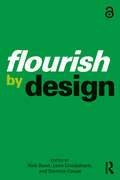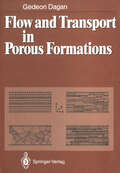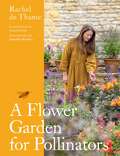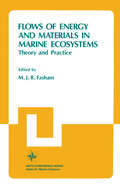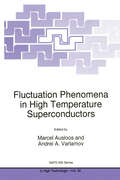- Table View
- List View
Florida Manatees: Biology, Behavior, and Conservation
by John E. Reynolds IIIManatees, the gentle giants of Florida's lagoons and coastal habitats, can bring a smile to the face of anybody lucky enough to spy one. As manatees dip and roll through the water, crowds gather to watch them feed on aquatic vegetation. Whether they are congregating by the hundreds or resting or feeding alone, viewing these sea cows can provide anyone interested in nature with hours of tranquil pleasure.Having survived for eons, today's manatees are now under constant threat due to our rapidly swelling human population. Their habitats are often devastated by development and pollution. The slow-moving manatees also live at the mercy of chance, for they occupy waters filled with fast-moving boats powered by razor-sharp propellers;¢;‚¬;€?a new form of predator from which they have no protection. Boat speed limits have been put in place to protect manatees, but there is a constant push to lift them so that people can once again zip across the waters that manatees call home. For this reason, manatees are often a subject of controversy that pits their lives against the rights of boat owners. In this book, manatee expert John E. Reynolds III and famed photographer Wayne Lynch join forces to reveal the clearest portrait of manatees ever published. Florida Manatees is a song for the manatee, a celebration of the lives of these majestic creatures. Reynolds's concise, informative text shares what scientists know about manatees, while Lynch's beautiful photographs instantly demonstrate how special these "potatoes with whiskers" really are. By encouraging an appreciation of manatees, the authors hope to help ensure a future in which Floridians can find ways to coexist with and continue to enjoy these uniquely wonderful sirenian inhabitants of their state.Included in this book: How manatees first came to Florida waters How manatees fit into the ecosystems of Florida What and how much manatees eat How manatees behave and communicate with one another Why manatees look the way they do Why manatees have whiskers How manatee mothers feed their young and much more
Flotation Reagents: Volume 2: Applications
by Dianzuo WangThis volume presents essential information on chemical reagents commonly used in flotation processes. It comprehensively summarizes the properties, preparation and applications of collectors, frothers, depressants and flocculants. It also discusses the microanalysis of flotation reagents and adsorption measurement. The book offers a valuable resource for all university researchers and students, as wells as R&D engineers in minerals processing and extractive metallurgy who wish to explore innovative reagents and technologies that lead to more energy efficient and environmentally sustainable solutions.
Flotation Reagents: Volume 1: Functional Principle
by Dianzuo WangThis book summarizes the author’s findings on the functional principle of flotation reagents, gathered over the past few decades. The fundamentals of and approaches common to surface chemistry are applied to study the reagents’ structure and performance, as well as their interaction with minerals. In particular, the book establishes the theoretical criteria for collector performance. It also includes the quantum chemistry parameters, steric configuration, HOMO and LUMO surface of various reagents. The book offers a valuable resource for all university graduate students, researchers and R&D engineers in minerals processing and extractive metallurgy who wish to explore innovative reagents and technologies that lead to more energy efficient and environmentally sustainable solutions.
Flourish by Design
by Nick Dunn Leon Cruickshank Gemma CoupeFlourish by Design brings together a range of established and emerging voices in design research for a collection that provides original provocations on topics of global significance. It is an insightful guide to original theory and practice concerning how we can design for a better tomorrow. Featuring contributors from a diverse array of backgrounds and professions, this edited book explores the difference that design and design research can make for people, organisations, and the planet to prosper now and in the future. It offers a range of ideas and techniques through practical examples and ongoing projects showing how applied design research can respond to global challenges. Covering topics as diverse as artificial intelligence, bio-inspired materials, more-than-human design, sustainability, and urban acupuncture, it shares interdisciplinary and transdisciplinary design research not just to demonstrate what could be plausible in the near future but also to explain why it might be preferable. By sharing these despatches, this collection represents the very best of what design research can do, explaining how and why. This book is intended for a wide audience of professionals, scholars, and students in design, architecture, and public policy, as well as anyone who has an interest in how we design the world and, in turn, it designs us.
Flourish by Design
Flourish by Design brings together a range of established and emerging voices in design research for a collection that provides original provocations on topics of global significance. It is an insightful guide to original theory and practice concerning how we can design for a better tomorrow. Featuring contributors from a diverse array of backgrounds and professions, this edited book explores the difference that design and design research can make for people, organisations, and the planet to prosper now and in the future. It offers a range of ideas and techniques through practical examples and ongoing projects showing how applied design research can respond to global challenges. Covering topics as diverse as artificial intelligence, bio-inspired materials, more-than-human design, sustainability, and urban acupuncture, it shares interdisciplinary and transdisciplinary design research not just to demonstrate what could be plausible in the near future but also to explain why it might be preferable. By sharing these despatches, this collection represents the very best of what design research can do, explaining how and why. This book is intended for a wide audience of professionals, scholars, and students in design, architecture, and public policy, as well as anyone who has an interest in how we design the world and, in turn, it designs us.
Flourishing: A Frank Conversation About Sustainability
by Andrew J. Hoffman John R. EhrenfeldFlourishing: A Frank Conversation about Sustainability invites you into a conversation between a teacher, John R. Ehrenfeld, and his former student now professor, Andrew J. Hoffman, as they discuss how to create a sustainable world. Unlike virtually all other books about sustainability, this one goes beyond the typical stories that we tell ourselves about repairing the environmental damages of human progress. Through their dialogue and essays that open each section, the authors uncover two core facets of our culture that drive the unsustainable, unsatisfying, and unfair social and economic machines that dominate our lives. First, our collective model of the way the world works cannot cope with the inherent complexity of today's highly connected, high-speed reality. Second, our understanding of human behavior is rooted in this outdated model. Driven by the old guard, sustainability has become little more than a fashionable idea. As a result, both business and government are following the wrong path—at best applying temporary, less unsustainable solutions that will fail to leave future generations in better shape. To shift the pendulum, this book tells a new story, driven by being and caring, as opposed to having and needing, rooted in the beauty of complexity and arguing for the transformative cultural shift that we can make based on our collective wisdom and lived experiences. Then, the authors sketch out the road to a flourishing future, a change in our consumption and a new approach to understanding and acting. There is no middle ground; without a sea change at the most basic level, we will continue to head down a faulty path. Indeed, this book is a clarion call to action. Candid and insightful, it leaves readers with cautious hope.
Flourishing Enterprise: The New Spirit of Business
by Chris Laszlo Judy Sorum BrownThe notion of responsible business has infiltrated our markets, and "going green" is now a part of our mindset. But, sustainability as we know it is not enough. Flourishing—the aspiration that humans and life in general will thrive on the planet forever—should be a key goal for every business today. This is a bold concept, like sustainability was a decade ago. Just as sustainability has become a matter of course, so too will flourishing become a cornerstone of business tomorrow. How are companies to attain this big-picture goal? Drawing together decades of research along with in-depth interviews, Flourishing Enterprise argues that many strategic, organizational, and operational efforts to be sustainable reach the potential of flourishing when they incorporate one additional ingredient: reflective practices. Offering more than a dozen such practices, this book leads readers down a path to greater business success, personal well-being, and a healthier planet. Readers will find that adding reflective practices to existing business efforts does not require more work; it simply changes the way we do our work and, more importantly, the results we achieve. Cultivating emotional and spiritual health is the next frontier; this future-oriented guide develops these core competencies while stretching the ongoing conversation about profitable, sustainable business.
Flourishing Within Limits to Growth: Following nature's way
by Sven Erik Jørgensen Brian D. Fath Søren Nors Nielsen Federico M. Pulselli Daniel A. Fiscus Simone BastianoniDecades of research and discussion have shown that the human population growth and our increased consumption of natural resources cannot continue – there are limits to growth. This volume demonstrates how we might modify and revise our economic systems using nature as a model. The book describes how nature uses three growth forms: biomass, information, and networks, resulting in improved overall ecosystem functioning and co-development. As biomass growth is limited by available resources, nature uses the two other growth forms to achieve higher resource use efficiency. Through a universal application of the three ‘R’s: reduce, reuse, and recycle, nature thus shows us a way forward towards better solutions. However, our current approach, dominated by short-term economic thinking, inhibits full utilization of the three ‘R’s and other successful approaches from nature. Building on ecological principles, the authors present a global model and futures scenario analyses which show that implementation of the proposed changes will lead to a win-win situation. In other words, we can learn from nature how to develop a society that can flourish within the limits to growth with better conditions for prosperity and well-being.
Flourishing Within Limits to Growth: Following nature's way
by Sven Erik Jørgensen Brian D. Fath Søren Nors Nielsen Federico M. Pulselli Daniel A. Fiscus Simone BastianoniDecades of research and discussion have shown that the human population growth and our increased consumption of natural resources cannot continue – there are limits to growth. This volume demonstrates how we might modify and revise our economic systems using nature as a model. The book describes how nature uses three growth forms: biomass, information, and networks, resulting in improved overall ecosystem functioning and co-development. As biomass growth is limited by available resources, nature uses the two other growth forms to achieve higher resource use efficiency. Through a universal application of the three ‘R’s: reduce, reuse, and recycle, nature thus shows us a way forward towards better solutions. However, our current approach, dominated by short-term economic thinking, inhibits full utilization of the three ‘R’s and other successful approaches from nature. Building on ecological principles, the authors present a global model and futures scenario analyses which show that implementation of the proposed changes will lead to a win-win situation. In other words, we can learn from nature how to develop a society that can flourish within the limits to growth with better conditions for prosperity and well-being.
Flow and Creep in the Solar System: Observations, Modeling and Theory (Nato Science Series C: #391)
by David B. Stone S. K. RuncornThe NATO ASI held in the Geophysical Institute, University of Alaska Fairbanks, June 17-28, 1991 was, we believe, the first attempt to bring together geoscientists from all the disciplines related to the solar system where fluid flow is a fundamental phenomenon. The various aspects of flow discussed at the meeting ranged from the flow of ice in glaciers, through motion of the solar wind, to the effects of flow in the Earth's mantle as seen in surface phenomena. A major connecting theme is the role played by convection. For a previous attempt to review the various ways in which convection plays an important role in natural phenomena one must go back to an early comprehensive study by 1. Wasiutynski in "Astro physica Norvegica" vo1. 4, 1946. This work, little known now perhaps, was a pioneering study. In understanding the evolution of bodies of the solar system, from accretion to present-day processes, ranging from interplanetary plasma to fluid cores, the understanding of flow hydrodynamics is essentia1. From the large scale in planetary atmospheres to geological processes, such as those seen in magma chambers on the Earth, one is dealing with thermal or chemical convection. Count Rumford, the founder of the Royal Institution, studied thermal convection experimentally and realized its practical importance in domestic contexts.
Flow and Transport in Fractured Porous Media
by Peter Dietrich Heinz Hötzl Jürgen Köngeter Rainer Helmig Martin Sauter Georg TeutschThis book addresses the characterization of flow and transport in porous fractured media from experimental and modeling perspectives. It provides a comprehensive presentation of investigations performed and analyzed on different scales.
Flow and Transport in Porous Formations
by Gedeon DaganIn the mid-seventies, a new area of research has emerged in subsurface hydrology, namely sto chastic modeling of flow and transport. This development has been motivated by the recognition of the ubiquitous presence of heterogeneities in natural formations and of their effect upon transport and flow, on the one hand, and by the vast expansion of computational capability provided by elec tronic machines, on the other. Apart from this, one of the areas in which spatial variability of for mation properties plays a cardinal role is of contaminant transport, a subject of growing interest and concern. I have been quite fortunate to be engaged in research in this area from its inception and to wit ness the rapid growth of the community and of the literature on spatial variability and its impact upon subsurface hydrology. In view of this increasing interest, I decided a few years ago that it would be useful to present the subject in a systematic and comprehensive manner in order to help those who wish to engage themselves in research or application of this new field. I viewed as my primary task to analyze the large scale heterogeneity of aquifers and its effect, presuming that the reader already possesses a background in traditional hydrology. This is achieved in Parts 3, 4 and 5 of the text which incorporate the pertinent material.
Flow and Transport in the Natural Environment: Advances and Applications
by W. L. Steffen and O. T. DenmeadThis volume arises from an International Symposium on Flow and Transport in the Natural Environment held in Canberra, Australia, in September 1987. The meeting was hosted by the CSIRO Division of Environmental Mechanics (now the Centre for Environmental Mechanics) to mark the opening of the second stage of its headquarters, the F.C. Pye Field Environment Laboratory, twenty-one years after the opening of the first stage. Those twenty-one years have seen much progress in our understanding of the physics of the natural environment and the occasion provided an ideal opportunity to review advances in our knowledge of flow and transport phenomena, particularly with regard to flow and transport in soils, plants and the atmosphere. The contents of this volume are based very closely on the Symposium's program. Undoubtedly, our choices of topics were idiosyncratic, but we believe that those we have selected exhibit progress, innovation, and much scope for practical application. Rather than being encyclopaedic, we have sought to deal with thirteen selected topics in depth.
Flow and Transport Processes with Complex Obstructions: Applications to Cities, Vegetative Canopies and Industry (NATO Science Series II: Mathematics, Physics and Chemistry #236)
by Yevgeny A. Gayev Julian C. R. HuntThis is the first book that reviews problems in different fluid mechanics disciplines that led to the concept of canopy, or penetrable roughness. Despite their diversity, many flows may be theoretically united by means of introducing distributed sinks and/or sources of momentum and heat and mass. These and other flows in engineering and environmental situations over surfaces with many obstacles are reviewed in terms of general concepts of fluid mechanics.
Flow Control (The IMA Volumes in Mathematics and its Applications #68)
by Max D. GunzburgerThe articles in this volume cover recent work in the area of flow control from the point of view of both engineers and mathematicians. These writings are especially timely, as they coincide with the emergence of the role of mathematics and systematic engineering analysis in flow control and optimization. Recently this role has significantly expanded to the point where now sophisticated mathematical and computational tools are being increasingly applied to the control and optimization of fluid flows. These articles document some important work that has gone on to influence the practical, everyday design of flows; moreover, they represent the state of the art in the formulation, analysis, and computation of flow control problems. This volume will be of interest to both applied mathematicians and to engineers.
The Flow Equation Approach to Many-Particle Systems (Springer Tracts in Modern Physics #217)
by Stefan KehreinThis self-contained introduction addresses the novel flow equation approach for many particle systems and provides an up-to-date review of the subject. The text first discusses the general ideas and concepts of the flow equation method, and then in a second part illustrates them with various applications in condensed matter theory. The third and last part of the book contains an outlook with current perspectives for future research.
Flow Noise: Theory
by Con Doolan Danielle MoreauThis book highlights the importance of sound produced by fluid flow or flow-induced noise. Noise created by unsteady flow creates high levels of environmental noise pollution, a known public health problem, and can compromise the acoustic qualities of marine vessels. There is a seemingly ever-growing list of modern technology that created flow-induced noise which includes aircraft, wind turbines, submarines, drones, high-speed rail, and cooling fans. More scientists and engineers are required to incorporate the effects of flow-induced noise in their work. This book also provides a comprehensive introduction to the theory underpinning the understanding of flow-induced noise.
A Flower Garden for Pollinators: Learn how to sustain and support nature with this practical planting guide
by Rachel de ThameThe perfect guide for any gardener looking for inspiration on how to create a pollinator-friendly garden all year round.Pollinators are essential to life on Earth. Yet bees, butterflies and other beneficial insects are struggling due to climate change and habit loss. Fortunately, what we choose to plant in our gardens can help them to thrive. In this heartfelt guide, horticulturalist and Gardener's World presenter Rachel de Thame highlights plants we can grow that are rich in nectar and pollen, ensuring the garden is filled with beautiful flowers for us all to enjoy year-round.Arranged by season and illustrated with exquisite hand-painted watercolours and glorious photography showcasing many of Rachel's favourite plants, this book provides a captivating look at how best to support nature. Whether you have a small urban courtyard or a large country garden, A Flower Garden for Pollinators will guide your choice of plants, attracting a host of pollinators to your own patch of paradise.'A wonderful journey through the magical world of plants.' - Frances Tophill
Flows of Energy and Materials in Marine Ecosystems: Theory and Practice (Nato Conference Series #13)
by M. J. FashamThe impetus for the conference held at Bombannes, France in May, 1982 arose out of a Scientific Committee on Oceanic Research (SCOR) Working Group on "Mathematical Models in Biological Oceanography". This group was chaired by K.H. Mann and held two meetings in 1977 and 1979. At both meetings it was felt that, although reductionist modelling of marine ecosystems had achieved some successes, the future progress lay in the development of holistic ecosystem models. The members of the group (K.H. Mann, T. Platt, J.M. Colebrook, D.F. Smith, M.J.R. Fasham, J. Field, G. Radach, R.E. Ulanowicz and F. Wulff) produced a critical review of reductionist and holistic models which was published by the Unesco Press (Platt, Mann and Ulanowicz, 1981). One of the conclusions of this review was that, whether holistic or reductionist models are preferred, it is critically important to increase the scientific effort in the measurement of physiological rates for the computation of ecological fluxes. The Working Group therefore recommended that an international meeting should be organized which would attempt to bring together theoretical ecologists and biological oceanographers to assess the present and future capability for measuring ecological fluxes and incorporating these data into models. An approach was made to the Marine Sciences Panel of the NATO Science Committee who expressed an interest in funding such a meeting. They awarded a planning grant and a planning group was formed consisting of M.J.R. Fasham, M.V. Angel, T. Platt, R.E.
Flows of Non-Smooth Vector Fields and Degenerate Elliptic Equations: With Applications to the Vlasov-Poisson and Semigeostrophic Systems (Publications of the Scuola Normale Superiore #22)
by Maria ColomboThe first part of the book is devoted to the transport equation for a given vector field, exploiting the lagrangian structure of solutions. It also treats the regularity of solutions of some degenerate elliptic equations, which appear in the eulerian counterpart of some transport models with congestion. The second part of the book deals with the lagrangian structure of solutions of the Vlasov-Poisson system, which describes the evolution of a system of particles under the self-induced gravitational/electrostatic field, and the existence of solutions of the semigeostrophic system, used in meteorology to describe the motion of large-scale oceanic/atmospheric flows.
Fluctuation Mechanisms in Superconductors: Nanowire Single-Photon Counters, Enabled by Effective Top-Down Manufacturing
by Holger BartolfHolger Bartolf discusses state-of-the-art detection concepts based on superconducting nanotechnology as well as sophisticated analytical formulæ that model dissipative fluctuation-phenomena in superconducting nanowire single-photon detectors. Such knowledge is desirable for the development of advanced devices which are designed to possess an intrinsic robustness against vortex-fluctuations and it provides the perspective for honorable fundamental science in condensed matter physics. Especially the nanowire detector allows for ultra-low noise detection of signals with single-photon sensitivity and GHz repetition rates. Such devices have a huge potential for future technological impact and might enable unique applications (e.g. high rate interplanetary deep-space data links from Mars to Earth).
Fluctuation Phenomena in High Temperature Superconductors (NATO Science Partnership Subseries: 3 #32)
by M Ausloos Andrei A. VarlamovThese Proceedings of a NATO-ARW (HTECH ARW 96 00 52) held at the International Center for Theoretical Physics, Trieste, Italy from Aug 5 till Aug 9, 1996 resulted from many discussions between various workers, concerning the need for a gathering of all (if possible) who were concerned about the subject of superconductivity fluctuations in High critical Temperature Superconductors (HTS). It appeared to many that the Skocpol-Tinkham work of 1975 had to be revitalized in view of the discovery of the new superconducting ceramics and the enormous amount of work having already taken place. The study of HTS is one of the most prominent research subject in solid state sciences. The understanding of the role of fluctuations is also thought to be necessary before technological applications since the fluctuations may destroy the superconducting state. The workshop discussions have touched upon (i) Superconducting fluctuations in the vicinity of the critical transition, (ii) Superconductivity fluctuations near the percolation transition, and (iii) Fluctuations of the vortex lattice at the lattice melting temperature. These topics served as initiators for a very great amount of discussions with many comments from the audience. More than forty "long lectures" and two "poster sessions" were held. Private discussions going unrecorded but obviously took place at many locations : lecture halls, staircases, cafetaria, bedrooms, bars, beach, . . .
Fluctuation Theorems under Divergent Entropy Production and their Applications for Fundamental Problems in Statistical Physics (Springer Theses)
by Yûto MurashitaThis book presents the derivation of the fluctuation theorems with divergent entropy production and their application to fundamental problems in statistical physics. It explores the two basic aspects of the fluctuation theorems: i) Applicability in extreme situations with divergent entropy production, concluding that the fluctuation theorems remain valid under the notion of absolute irreversibility, and ii) utility in the investigation of classical enigmas in the framework of statistical physics, i.e., Gibbs and Loschmidt paradoxes. The book offers readers an overview of the research in fundamental statistical physics. Firstly it briefly but skillfully reviews the modern development of fluctuation theorems to found the key theme of the book. Secondly it concisely discusses historical issues of statistical physics in chronological order, along with the key literature in the field. They help readers easily follow the key developments in the fundamental research of statistical physics.
Fluctuations and Non-Equilibrium Phenomena in Strongly-Correlated Ultracold Atoms (Springer Theses)
by Kazuma NagaoThis book discusses non-equilibrium quantum many-body dynamics, recently explored in an analog quantum simulator of strongly correlated ultracold atoms. The first part presents a field-theoretical analysis of the experimental observability of the Higgs amplitude mode that emerges as a relativistic collective excitation near a quantum phase transition of superfluid Bose gases in an optical lattice potential. The author presents the dynamical susceptibilities to external driving of the microscopic parameters, taking into account a leading-order perturbative correction from quantum and thermal fluctuations and shows clear signatures of the Higgs mode in these observables. This is the first result that strongly supports the stability of the Higgs mode in three-dimensional optical lattices even in the presence of a spatially inhomogeneous confinement potential and paves the way for desktop observations of the Higgs mode. In the second part, the author applies the semi-classical truncated-Wigner approximation (TWA) to far-from-equilibrium quantum dynamics. Specifically, he considers the recent experiments on quantum-quench dynamics in a Bose-Hubbard quantum simulator. A direct comparison shows remarkable agreement between the numerical results from TWA and the experimental data. This result clearly indicates the potential of such a semi-classical approach in reliably simulating many-body systems using classical computers. The book also includes several chapters providing comprehensive reviews of the recent studies on cold-atomic quantum simulation and various theoretical methods, including the Schwinger-boson approach in strongly correlated systems and the phase-space semi-classical method for far-from-equilibrium quantum dynamics. These chapters are highly recommended to students and young researchers who are interested in semi-classical approaches in non-equilibrium quantum dynamics.



